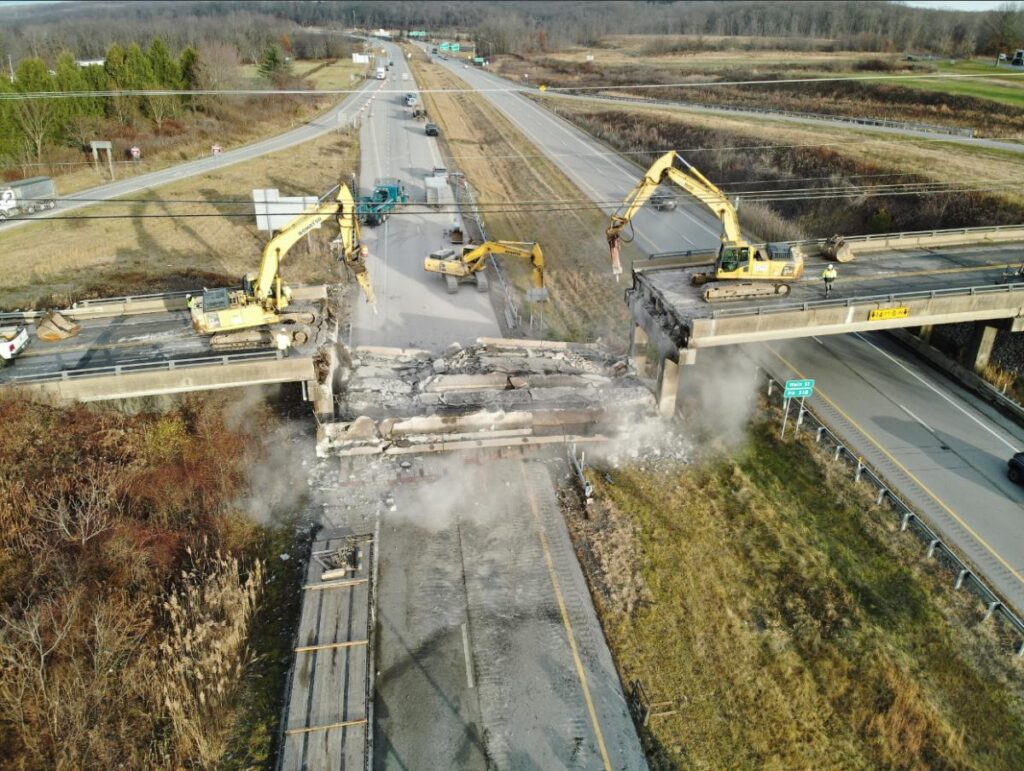Photo courtesy of PennDOT
The western section of the bridge, over Interstate 376 in Shenango Township, was significantly damaged Dec. 7 in an accident that saw the boom of an eastbound roll-off truck strike the span.
Construction of a higher and wider replacement for the heavily damaged Pennsylvania Highway 318 bridge in Mercer County could begin as early as April, officials with the state Department of Transportation (PennDOT) said recently.
During a Jan. 18 public meeting, with more than 20 people in attendance at the West Middlesex municipal building, PennDOT and engineers it hired for the estimated $6.5 million project gave details of the preliminary bridge replacement plan.
“We are moving at light speed as far as PennDOT is concerned,” said Mark Nicholson, the state agency’s project engineer.
The western section of the bridge, over Interstate 376 in Shenango Township, was significantly damaged Dec. 7 in an accident that saw the boom of an eastbound roll-off truck strike the span.
For the safety of traffic traveling eastbound under the bridge, it was determined the damaged portion of the bridge should be removed as soon as possible. The spans over the westbound lanes remain intact.
Shortly afterward, PennDOT said it was better to replace the bridge instead of attempting to fix it, the Meadville Tribune reported.
The old structure was estimated to have had a 100-year lifespan when it was installed in 1966, decades before the former four-lane Pa. Highway 60 was converted into an interstate in 2009.
Preliminary engineering plans to replace the bridge should be finalized by the end of January with construction bids to be let by mid-March, Nicholson said. Construction could begin in the spring with a September or October 2024 completion date.
Steel Spans to Make It Easier to Build New Bridge
In speaking with the Tribune after the Jan. 18 community meeting, Nicholson said PennDOT normally takes two years to finalize most bridge engineering designs.
Its current blueprints show the new Pa. 318 bridge will look a little different from its predecessor. For one, it will be 16-ft.-10 in. above I-376. It also will have a higher vertical clearance of approximately 2 ft. and will meet the current federal highway standards.
Additionally, the new Pa. 318 bridge will have steel spans rather than the concrete ones found on the old structure.
“Using steel rather than concrete will make it easier to raise the bridge,” explained Richard Schoeder, an engineer with Michael Baker International, following the meeting. The Pittsburgh-based engineering firm was hired by PennDOT to assist in designing the new bridge.
Concerns raised by members public attending the forum included closing one section of I-376 for extended periods during the construction. PennDOT representatives said they would try to minimize that by doing work requiring temporary road closure over weekends.
Schoeder added that the seven beams needed for the bridge’s construction would only require I-376 to be closed for 15 to 20 minutes for each beam’s installation.
According to PennDOT, the project also will include some Pa. 318 roadway reconstruction to tie the new bridge into the existing highway. Additionally, plans call for rebuilding a portion of three of the interchange ramps, making drainage upgrades, replacing guiderails, erecting new roadside signage and updating pavement markings. Minor shoulder improvements and roadway repairs to I-376 under the new bridge also will be completed.
When a West Middlesex town council member requested the creation of a crossing for emergency vehicles on I-376 in that area, though, Nicholson indicated he should not get his hopes up.
“I think there’s a slim chance of getting that approved,” the PennDOT engineer said.
No bonuses will be given if the contractor completes the bridge early, he added, but daily penalties, typically running thousands of dollars, will likely be assessed against the contractor for each day it is late.
PennDOT is seeking to recoup some of the costs to replace the bridge from the trucking company involved in the accident.
However, because of how PennDOT funding flows, it may require local road and bridge projects that are already planned to be delayed a year or two, Nicholson told the Tribune.
Read the full article here











